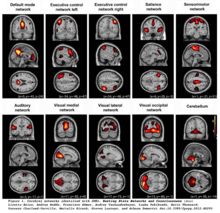Large scale brain networks
Large scale brain networks are collections of widespread brain regions showing functional connectivity by statistical analysis of the fMRI BOLD signal or other signal fluctuations.[1] Functional connectivity may be measured as long-range synchronization of the EEG, MEG, or other dynamic brain signals.[2] Synchronized brain regions may also be identified using spatial independent component analysis. The set of identified brain areas that are linked together in a large-scale network varies with cognitive function.[3] When the cognitive state is not explicit (i.e., the subject is at "rest"), the large scale brain network is a resting state network (RSN). As a physical system with graph-like properties,[2] a large scale brain network has both nodes and edges, and cannot be identified simply by the co-activation of brain areas. Large scale brain networks are identified by their function, and provide a coherent framework for understanding cognition by offering a neural model of how different cognitive functions emerge when different sets of brain regions join together as self-organized coalitions.
Networks

The following four networks have been identified by at least three studies.
- Dorsal attention: voluntary deployment of attention and reorientation to unexpected events.[1][4][5][7]
- Salience: monitors the salience of external inputs and internal brain events.[1][2][4][6]
- Lateral visual: important in complex emotional stimuli.[4][5][6]
Several other brain networks have also been identified: auditory,[4][6] motor,[4] right executive,[4][6] posterior default mode,[4] left fronto-parietal,[5] cerebellar,[5][6] ventral attention,[5][7] spatial attention,[1][2] language,[2] left executive,[6] and sensorimotor.[6] There are also models suggesting that “components of memory representation are distributed widely across different parts of the brain as mediated by multiple neocortical circuits”.[8]
References
- 1 2 3 4 5 Riedl, Valentin; Utz, Lukas; Castrillón, Gabriel; Grimmer, Timo; Rauschecker, Josef P.; Ploner, Markus; Friston, Karl J.; Drzezga, Alexander; Sorg, Christian (January 12, 2016). "Metabolic connectivity mapping reveals effective connectivity in the resting human brain". PNAS. 113 (2): 428–433. doi:10.1073/pnas.1513752113. Retrieved 24 January 2016.
- 1 2 3 4 5 6 Bressler, Steven L.; Menon, Vinod (June 2010). "Large scale brain networks in cognition: emerging methods and principles". Trends in Cognitive Sciences. 14 (6): 233–290. doi:10.1016/j.tics.2010.04.004. Retrieved 24 January 2016.
- ↑ Bressler, Steven L. "Neurocognitive networks". Scholarpedia. 3 (2): 1567. doi:10.4249/scholarpedia.1567. Retrieved 23 March 2016.
- 1 2 3 4 5 6 7 8 Yuan, Rui; Di, Xin; Taylor, Paul A.; Gohel, Suril; Tsai, Yuan-Hsiung; Biswal, Bharat B. (30 April 2015). "Functional topography of the thalamocortical system in human". Brain Structure and Function. doi:10.1007/s00429-015-1018-7. Retrieved 24 January 2016.
- 1 2 3 4 5 6 Bell, Peter T.; Shine, James M. (2015-11-09). "Estimating Large-Scale Network Convergence in the Human Functional Connectome". Brain Connectivity. 5 (9). doi:10.1089/brain.2015.0348. PMID 26005099.
- 1 2 3 4 5 6 7 8 Heine, Lizette; Soddu, Andrea; Gomez, Francisco; Vanhaudenhuyse, Audrey; Tshibanda, Luaba; Thonnard, Marie; Charland-Verville, Vanessa; Kirsch, Murielle; Laureys, Steven; Demertzi, Athena (2012). "Resting state networks and consciousness. Alterations of multiple resting state network connectivity in physiological, pharmacological and pathological consciousness states.". Frontiers in Psychology. 3. doi:10.3389/fpsyg.2012.00295.
- 1 2 Vossel, Simone; Geng, Joy J.; Fink, Gereon R. (2014). "Dorsal and Ventral Attention Systems: Distinct Neural Circuits but Collaborative Roles". The Neuroscientist. 20 (2): 150–159. doi:10.1177/1073858413494269. PMID 23835449.
- ↑ Ofengenden, Tzofit (2014) Memory formation and belief. Dialogues in Philosophy, Mental and Neuro Sciences, 7(2):34-44 http://www.crossingdialogues.com/Ms-A14-03.pdf